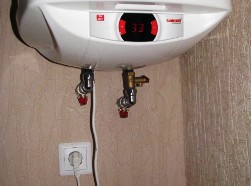Categories: Electrician at home, Electrical connection of equipment
Number of views: 39619
Comments on the article: 8
Correct connection of powerful power consumers
 One of the distinguishing features of household electrical networks of large country houses is the presence of a large number of powerful power consumers. In addition to the traditional electric stove, it can be various hot water boilers, ventilation and pump installations, and some in the common house economy can even find professional stationary machines or other industrial units that operate on electricity.
One of the distinguishing features of household electrical networks of large country houses is the presence of a large number of powerful power consumers. In addition to the traditional electric stove, it can be various hot water boilers, ventilation and pump installations, and some in the common house economy can even find professional stationary machines or other industrial units that operate on electricity.
Powerful receivers can be considered those devices whose current rating exceeds the limit for the most powerful 220 volt sockets. This limit is 16 amperes, which corresponds to approximately 3.5 kilowatts for a single-phase network. Not so little, if you look. Indeed, for example, quick-boiling kettles have an average power of only two kilowatts, and most other household appliances - even less.
But the fact is that the socket can be used to connect, but not to turn on the device. After all, having connected the same kettle to the outlet, we are also forced to click its switch so that the water begins to warm. If you close the controls and “force” the kettle to turn on immediately after the plug enters the outlet, the contacts of the latter will start to burn at each turn-on due to an electric arc. This inevitably leads to an early failure of the outlet, and, in addition, does not exclude the occurrence of a fire.
So, sockets are used to connect devices, and switches are used to turn them on. But usually only complete devices are equipped with their own switches, which do not require any special knowledge from the user. And, for example, the same hot water boilers can be sold "as is", in the "naked" form, giving the consumer complete freedom of action in choosing a connection method.
In this case, you can, of course, use an ordinary switch of an overhead or built-in design. But these switches are designed for switching lighting circuits and the maximum load that they can control is only about two kilowatts. And with this load, the contacts of such a switch very soon burn up and cease to fulfill their function.
Therefore, you can turn on a powerful load in two ways:
1) using additional circuit breakers that perform the function of ordinary switches;
2) using electromagnetic starters equipped with a push-button station (buttons "start" and "stop").
The nominal value of devices intended for putting into operation powerful electric receivers (as well as, by the way, lighting circuits with a large number of fixtures consuming a large amount of energy) must be selected with a substantial margin. After all, switching to the maximum permissible load can in no way be called favorable. First of all, this applies to machines.
So, with a rated load of 16 amperes, you should choose a circuit breaker for 25-32 amperes, with a load of 23 amperes - at 40 amperes and so on. To ensure electrical safety and to maintain an acceptable interior, modular circuit breakers for switching high-power loads should be placed in separate plastic boxes, and starters should be selected that have their own case with buttons for starting and stopping.
In addition, all stationary power consumers having a power above two kilowatts, it is advisable to power from a separate machine in the switchboard. This machine will perform the functions of overcurrent protection, and therefore its value should be selected with great care. Protection against leakage currents will not be superfluous, especially if the power receiver is located in a room with increased danger (bathroom, bathhouse, kitchen).Then the automaton must be differential, or must be present RCD.
An example of connecting powerful consumers:
Connection of an electric stove and a washing machine in the TN-C system
See also at e.imadeself.com
:
